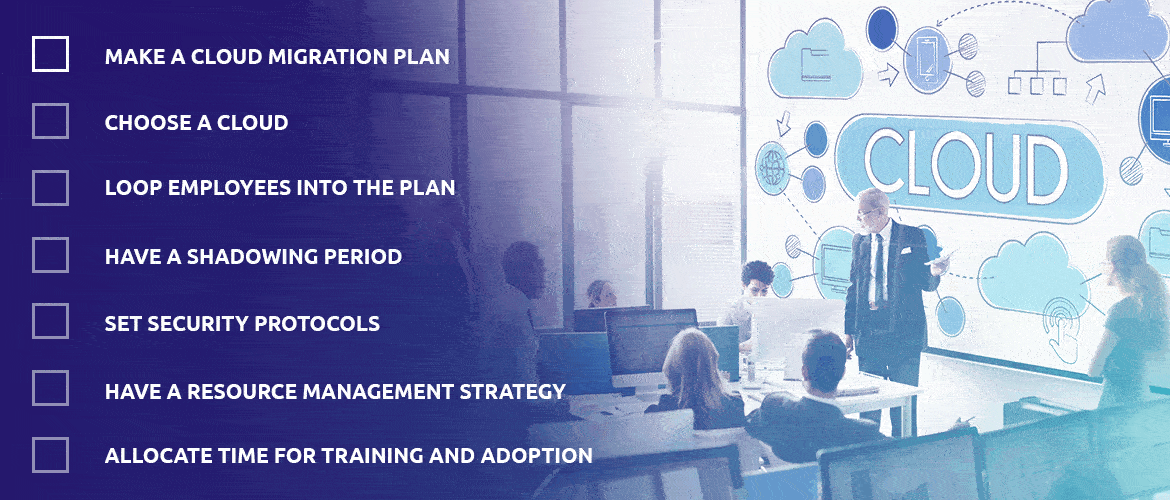While logically it makes sense to embrace the on-premises to Cloud migration, other concerns crop up, not the least being the issue of downtime, data loss, and security breaches. If your organization is looking to modernize mission-critical applications and planning a cloud migration as part of this process, you don’t want to repeat others’ mistakes.
When planning for cloud database migration, enterprises need to follow a reliable checklist and ensure that the process proceeds without any issues. Below is a complete cloud migration checklist with points that will help every business during the process:

I. Make a Cloud Migration Plan
The first point on this cloud migration checklist is mapping out a detailed process before the cloud migration process begins. During this planning session, a business needs to be very clear about the challenges that may arise and note them down. The first challenge is the migration process itself; this could impact workflow and, therefore, needs to be scheduled when it will have minimum impact on the business.
The next big challenge is the loss of data that could occur during the migration process. To mitigate the risks of data loss, companies must collaborate with recognized cloud service providers. By meticulously evaluating current infrastructure, service providers can create a personalized checklist for cloud migration with security and compliance in mind. This approach empowers enterprises to orchestrate seamless transition and foster agility in the cloud environment.
Choosing a cloud and having adequate security are two more common challenges businesses struggle with. It’s also crucial for enterprises to evaluate existing processes for any complexities that could impact migration efficiency. These issues will be dealt with in more detail in this blog.
II. Choose a Cloud
There are four options when choosing a cloud: public, private, hybrid cloud, and hybrid infrastructure.
-
Public Cloud
A public cloud exists on the internet and offers offsite storage. Public clouds are preferred during collaborative projects, developing and testing code for applications, and when a company needs incremental capacity. The main advantage of a public cloud is its ease of accessibility, which is required for shared resources. However, the main disadvantage is that it is relatively more vulnerable to security breaches. Any organization that chooses a public Cloud should address the security concerns that could arise right at the start of the migration process.
-
Private Cloud
Companies can own private clouds on their internal networks. While accessibility is limited for a private cloud, this option is ideal for storing sensitive data and when companies need to show compliance with government regulations. Private clouds have higher security over which the company has complete control.
-
Hybrid Cloud
As the name states, the hybrid cloud combines public and private cloud systems. In this case, the private cloud can store data while shareable information can be on the public cloud. This option offers the user the best of both worlds, but with the challenge of maintaining two platforms and migrating data separately.
-
Hybrid Infrastructure
The fourth option is a hybrid between physical and cloud storage. In this case, an organization can retain some of its information on-premises and move the rest to the cloud. When choosing a plan for application migration to the cloud, the dependencies between applications must be well documented. Any issues that could arise can be identified, and suitable measures are taken to resolve them.
III. Loop Employees into the Cloud Data Migration Strategy
All employees need to be informed of the cloud migration strategy. Not all of them might be comfortable with the changes that the migration entails, which is why the CEO/CTO, or the senior manager/engineer, should conduct an orientation session to train all those involved with the new system. Employees can be given a chance to test the process, giving them a feel of the new infrastructure and checking runtimes and integration points.

Where sensitive data is involved, management can take a call on which employees have access to the information on the cloud. Employees that have access to the data should be given the correct security clearance, and all logins should be recorded.
IV. Have a Shadowing Period
While designing a cloud migration strategy, beta testers or power users should set aside a shadowing period for observing and testing. This helps in pointing out any issues that may impact a smooth rollout to a broader audience. As many functions as possible should be tested to ensure that all systems are running without a problem. Issues that do come up can be resolved during the shadowing period.
V. Set Security Protocols
Regardless of whether the data is susceptible to medical and financial records or less sensitive like buyer preferences, it should not fall into the wrong hands. A two-step verification process can help keep data more secure, and regular security upgrades can protect the whole system. When choosing a cloud provider, the security policies and measures should be reviewed carefully to ensure the safety of the stored information. Security protocols should be set in place within the organization so that only authorized personnel have access.

For instance, HIPAA-compliant companies need to first check with their cloud provider if the required measures have been taken for data protection, their data encryption practices, and their safety track record. If additional security is needed, companies can talk to their service provider about their options to ensure that their data is secure.
VI. Have a Resource Management Strategy
Every company that chooses a cloud migration strategy needs to keep in mind that several changes will have to be made during the shift. Among these changes is the need to invest in cloud monitoring tools, hiring new employees that are qualified to use those tools, and reassigning employees who monitored physical storage devices to new tasks. In some cases, the organization might have to outsource the cloud monitoring to the cloud service provider when hiring new talent is beyond its scope.
Processes that were previously handled in-house would now be carried out offsite, and a new flow of events will develop. Even if a new team is recruited to keep cloud monitoring and computing within the company, a support partner would be required to assist with the initial transition and any problems. The need for these resources will have to be accounted for during the cloud migration planning stage.
VII. Allocate Time for Training and Adoption
A migration is incomplete without a reasonable training period. Users need to be informed and prepared for the changes and challenges that will impact how they have been using the systems/infrastructure until that point. They need to be given demonstrations and trained to use the new system so that they are comfortable with it and aware of its advantages. Speed, performance, and security are a few advantages that could entice users to adopt the new system.
IX. Use Metrics for Cost Optimization
Cloud migration is often driven by the promise of cost savings, but it’s essential to monitor and optimize costs continuously. The last step in the migration to cloud checklist is using standard metrics related to cost optimization and maximizing the value. Metrics related to cost optimization include:
- Total Cost of Ownership (TCO)- Calculating the TCO helps compare the overall cost of running applications on-premises versus in the cloud, considering factors such as infrastructure, licensing, and operational expenses
- Resource Utilization- Monitoring resource utilization allows for identifying underutilized resources and rightsizing instances to optimize costs without sacrificing performance
- Cost Per Transaction or User- Analyzing the cost per transaction or user helps assess the efficiency of cloud resources in delivering value to the business
Cloud migration is the need of the hour for any organization that deals with large amounts of data. By abiding by the points on this Cloud migration checklist, companies can have a smoother and cost-effective transition, reduce downtime, and find a cloud-based storage system that matches their business goals.





